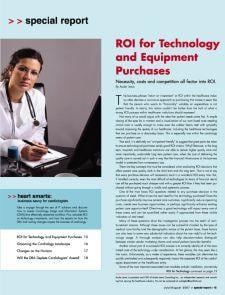
The business phrase “return on investment” or ROI within the healthcare industry often denotes a caricature approach to purchasing that makes it seem like that the person who wants to financially validate an expenditure is not patient friendly. In reality, this notion couldn’t be further from the truth of what a strong ROI process within healthcare institutions should represent.
Not many of us would argue with the idea that patient needs come first. A simple closing of the eyes for a moment and a visualization of our own loved ones needing critical care is usually enough to make even the coldest hearts melt with sympathy toward improving the quality of our healthcare, including the healthcare technologies that we purchase on a day-to-day basis. This is especially true within the cardiology arena of patient care.
That said, it is definitely not “anti-patient friendly” to suggest that great pains be taken to ensure technological purchases satisfy good ROI criteria. Why? Because, in the long term, hospitals and healthcare institutions are able to deliver higher quality care and more importantly, sustainable long term patient care, when the cost of delivering the quality care is carried out in such a way that the financial infrastructure of the business model is protected from unnecessary loss.
There are key concepts that must be considered when evaluating ROI decisions that affect patient care quality, both in the short term and the long term. That is not to say that every purchase decision will necessarily result in a wonderful ROI every time. But, if handled correctly, even the most difficult of technologies (in terms of financial return) can still be purchased much cheaper and with a greater ROI than if they had been purchased without going through a viable and systematic process.
One of the most basic ROI questions related to any purchase decision is the question of need. What drives the real need for the technology purchase? Does the purchase significantly improve patient care outcomes, significantly reduce operating costs, create new business opportunities, or perhaps significantly enhance existing patient care opportunities? Oftentimes, a good technology will impact every one of these areas and can be quantified rather easily if approached from these visible indicators of real need.
Many of these questions drive the investigation process into the realm of reimbursement science. Although these issues can be somewhat clouded by the type of medical care facility and the demographic nature of the patient base, these factors can also lead to some very substantial indicators about the true viability of the technology usage. A thorough analysis can also help decision-makers distinguish between simple vendor marketing claims and actual patient/provider benefits.
Another critical part of a successful ROI process is to correctly identify all of the associated costs of the technology under consideration. At first glance, this may seem like a trite truism. Unfortunately, as a matter of experience, these variables can oftentimes be quickly overlooked and subsequently negatively impact the expected ROI of the cardiologists department or the healthcare entity.
Some of the most important associated cost variables include: installation, connectivity and interface; architectural drawings, design and review; construction or structural change; additional utilities; maintenance, service and repair; recruitment, hiring or training; disposal or environmental; extra options, features or functions; additional memory, storage or utilization; comparative costs between purchasing, leasing or fee-for-use; and procedural supplies and/or inventory.
Without a doubt, some of the most important ingredients in a successful ROI process are the steps that are taken to keep the vendor environment competitive throughout the entire evaluation and purchase period. It is difficult to quantify the major damage that can be done to a purchase process when a particular vendor is “anticipating” a sure sell of their technology to a cardiology department or healthcare entity. That said, many vendors will take drastic steps to ensure a biased attraction to the purchase decision.
The analysis of performance, fit, function and value between vendor equipment and technologies should be based on a process that quantifies the differentials and also ties back into a set of clearly stated end goals for the overall project. A competitive environment helps to ensure a strong ROI!
